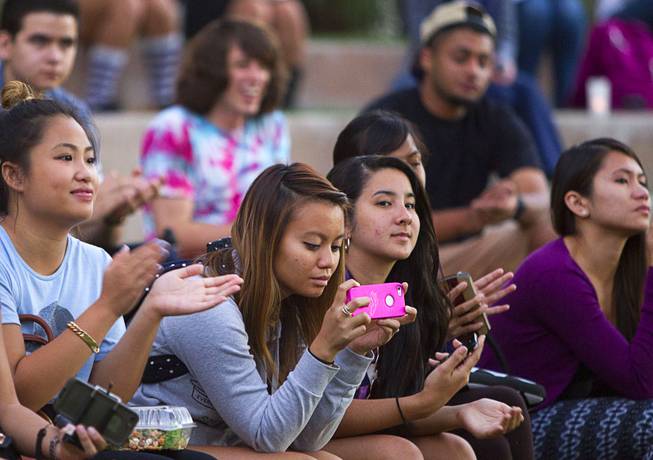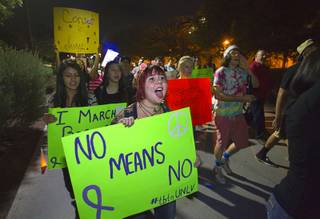
Geselle Rufin, center, and other members of the Alpha Phi Gamma sorority listen to speakers during the 21st Annual Take Back the Night rally at UNLV Thursday, Oct. 23, 2014. Alpha Phi Gamma’s national philanthropy is the Fight Against Violence Towards Women, she said.
Sunday, Nov. 2, 2014 | 2 a.m.
When UNLV student Carmella Gadsen found out someone close to her had been raped, she didn’t know where to turn.
Then she heard about the university’s Campus Advocacy Resource and Empowerment group.
The group welcomed her, offering counseling and giving her information about the legal options that existed for her friend. The experience prompted Gadsen, 22, to take action.
“I didn’t want to sit idly by and do nothing,” Gadsen said. “I wanted to put my foot down against people who think they can do horrible things and get away with it.”
The experience played a role in her becoming a CARE advocate and now the organization’s president. CARE’s goal, like Gadsen’s, is to transform the culture on college campuses to eradicate sexual assault and domestic violence. The group and others like it teach students how to protect themselves and each other on a campus where UNLV police received 22 reports of dating violence, stalking and domestic violence last year.
“Violence has to be attacked from many different fronts,” Gadsen said. “You can’t just support a survivor without trying to end the violence.”
CARE tries to visit freshman classes to ensure students are trained in how to avoid being victimized and how to intervene if they see violence happening. Students are instructed to explicitly ask for consent to sex, to avoid any ambiguity about intentions. They are taught that consent can’t be given if someone is intoxicated.
A key message for bystanders: It often doesn’t take much more than speaking up to prevent an assault.
CARE’s goal is that in four years, every student will be trained in bystander intervention.
“We’re trying to teach these kids that we have to be proactive bystanders, and in some way, safely prevent violence from occurring,” Gadsen said.
UNLV also brought in a nonprofit group, Green Dot, for a four-day faculty and staff training on three key bystander intervention techniques — direct intervention, distraction and delegation, such as calling a residential adviser or police.
Jessy Lyons, associate director of Green Dot, compares intervention to wearing a seat belt. While most times a situation may not rise to the level of violence, choosing to do nothing can have devastating consequences.
“There are lots and lots of reasons to be hopeful,” Lyons said. “Bystanders far outnumber the people who will commit violence, like 20 or 30 or 40 to 1. If we’re in the majority, we can absolutely bring numbers down and bring it down quickly.”


Join the Discussion:
Check this out for a full explanation of our conversion to the LiveFyre commenting system and instructions on how to sign up for an account.
Full comments policy